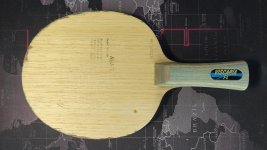says
Spin Wins!
says
Spin Wins!
Member
Ha, 1hr of 2hr session was recorded, editing can do wonders!!! Maybe 5 mins out of an hour used, not hard to imagine what the other 55 mins was like!!! More bad than good!!
Anyway, the sessions are based on 3 main areas.
1) Serve and 3rd ball attack, 5th ball follows on. spin rather than power/speed. Find the right ratio of spin, power and speed, decision making, full out attack on the ‘right‘ ball. Safer ball with good spin and placement, enough speed etc.
2) Return of serve, reading spin, placement, and how Gun ho you go with the return of serve, decision making again!! Risky, Safe or somewhere in between, how to put some pressure on opponent, what’s uncomfortable and not the return they expect. Tom liked some swipe pushes I did, playing with the spin rather than against it as well. These types of return are not really used at our level.
3) Recovery, footwork, movement and ‘smart‘ anticipation, moving in advance to a slightly advantageous position, because there is a higher % or likelihood that the stroke opponent will play will be to a certain area of the table. Similar to ‘resetting your middle/ centre’ when receiving serve, which we have discussed previously.
Item 3 is always part of items 1 and 2
Last session we worked on which serve action was best for me.
BH serve, FH pendulum, FH reverse pendulum, FH hook????? (Didn’t even go down the FH tomahawk route, I have that serve but use it rarely)
The outcome was use FH pendulum and FH hook serve, I was reading the return better, smart anticipation was better. Therefore 3rd ball attack was better.
Disguise of hook serve is good, opponents can become very uncomfortable when receiving my hook serve ( at my level or slightly higher )
Disguise of FH pendulum is I would class as average at best, so I’ll work on how that can be improved. But I have good spin variation, placement etc
So, BH serve, use for safety and faster recovery.
FH reverse pendulum has some good variation and deception but is edged out by how I recover and anticipate serve return.
These 4 serve actions will still be practiced and hopefully improved, but there will be generally 2 serve actions used in the majority. It is still worth having the other 2 serve actions, because sometimes changing to a BH serve or Reverse pendulum reaps rewards. something to throw into the mix if an opponent is returning your preferred serves well. They may not be as aggressive or return well to a lower %, its strange that a player can struggle with a different serve action, angle of serve, even a change of serve starting position can cause trouble!!
one take away for me is you are clear which serve(s) most likely give you a 3rd ball you understand & can see well to open
btw, do you have a fast, deep dead (at the other's middle)?
how about a short, low spin (or dead)? did you watch the craig bryant video wrighty put up earlier post?














